THE STRAITS TIMES – Malaysia’s COVID-19 infectivity rate has inched up, as daily caseloads showed a marginal uptick over the past couple of days, but health authorities said the situation is still under control.
While they are anticipating an Omicron wave in Malaysia, experts say that the highly contagious variant is not yet the primary driver for the majority of cases.
Malaysia’s R-naught (RO) value for COVID-19 infection reached 1.0 on Tuesday, before dropping back marginally to 0.99 on Wednesday.
RO is a measure of the number of new infections generated by each case. A rate of 1 means that any infected person will on average infect one other person.
The last time Malaysia’s infectivity rate breached 1.0 was on November 23 last year, before Omicron was designated a variant of concern by the World Health Organisation (WHO).
The country recorded 3,684 cases yesterday, the third consecutive day cases had increased. It is the highest daily caseload so far this year, and the highest since December 30 last year when the country reported 3,997 cases.

However, as of last week, Malaysia had detected 245 Omicron cases, and the number of local cases of the new variant was still in the double digits, at 17.
Around two-thirds of Omicron cases in Malaysia involved pilgrims who recently returned from Saudi Arabia, some of whom were reportedly unvaccinated prior to their pilgrimage.
In response, Malaysia last week suspended Umrah trips to Saudi Arabia for a month, as it sought to keep Omicron cases under control.
Universiti Putra Malaysia epidemiologist Malina Osman told The Straits Times (ST) that the current uptick in cases could be caused by violations of COVID-19 protocols as well as Omicron, although the latter can be confirmed only after full genome sequencing by the Health Ministry.
“If cases due to Omicron are increasing steadily, and subsequent findings show that overwhelming cases were due to Omicron, then we can conclude the role (of Omicron),” she told ST.
Dr Malina said the situation looked to be still “within control”, with active cases continuing to decline in the country.
Malaysia had 39,896 active cases as at Wednesday, a reduction of 17 cases from the day before as recoveries continued to outpace new cases. The number is a far cry from more than 200,000 active cases in August last year – by far the worst month since the pandemic started in Malaysia.
More than 80 per cent of active cases are serving home quarantine orders – normally issued for those with mild or asymptomatic infections.
The country recorded 21 deaths on Wednesday, with deaths being in the low double digits for much of the past month. The highest record is the 592 deaths on September 11 last year.
Health Minister Khairy Jamaluddin had said that there is a “high possibility” of an Omicron wave in Malaysia, and warned that daily caseloads could reach 30,000 by March if the variant is not managed with interventions such as the Umrah travel suspension.
Malaysia’s highest daily caseload was 24,599 recorded in August last year.
Both Khairy and Senior Minister in charge of Defence Hishammuddin Hussein had said that Malaysia will avoid implementing another lockdown to deal with a possible Omicron wave.
Malaysia spent a large part of 2021 under some form of lockdown and travel restriction to deal with the Delta variant. But this did little to slow the spread of Delta, making 2021 the deadliest year during the pandemic for Malaysia.
The country has re-opened most businesses and lifted all domestic travel restrictions since mid-October, after vaccinating more than 90 per cent of its adult population. It retains social distancing protocols and the mask mandate for all social activities.
As at Wednesday, Malaysia has fully vaccinated 78.6 per cent of its total population, with 26 per cent having also taken their booster shots.







